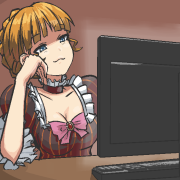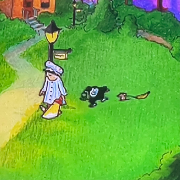|
WWWWWWWWWWWWWWWWWW posted:if that were the case wouldn't PSP games look better on the vita? they look shittier, despite the vita having a much better screen. I think this concern was misplaced since most 4K TVs handle 1080p blu-rays beautifully, as it's a perfect integer scale to display them at 2160p. Arguably better even, because newer TVs have better contrast ratio and pixel density.
|
|
|
|

|
| # ? Apr 26, 2024 08:50 |
|
Weedle posted:hard question to answer because no 3ds can do integer scaling for ds games due to the display resolution. it sounds like you're using "blocky"/"blockier" to refer to how big and clearly visible the individual pixels are, though, so if we're talking a hypothetical 3ds that could run ds games at 2x (512x384) on a 3ds-sized display, games on the the dsi xl would look "blockier" due to its larger display Yeah, your image is what I feel like NES/SNES/Genesis/PS1 games look like on 480p and higher screens. That's exactly what I mean when I keep saying "blockier". Unless the RG-351 has some crazy screen technology that I am not aware of, I have never liked the way 8 and 16 bit games looked on HD displays. Pablo Nergigante posted:Uncle at Nintendo I think you just like the way the more apparent pixels/subpixels on a lower res LCD look I honestly don't know what the hell I like haha. I'm more surprised at how bad I am at explaining it. When I was buying an arcade monitor for my MAME cabinet everyone was telling me "make sure it's standard res or most of your games will look like poo poo!". As such 95% of my games are indistinguishable from their real jamma boards. Isn't that the same deal?
|
|
|
|
CRTs don't have a resolution in the same way fixed pixel displays do. Their primary limitation is how many lines the electron gun can scan in a pass down the tube. What they do have is: a. No input lag b. Proper handling of interlaced video (including 240p) c. They're pretty small d. The traits below e. Nostalgia It's also not like you can't make out the pixels on a CRT. Edges are less sharp due to a non-square phosphor mask, color bleed, and video noise, but the individual units are still distinct. f. a deafening hum on this particular one
|
|
|
|
Chumbawumba4ever97 posted:Maybe it will make more sense if I use a photograph instead of video game but it would be like saying the picture on the right looks the same or better than the one on the left You keep posting blown up images next to tiny images and it's all completely pointless because you're looking at them on the same screen. It's not the same as looking at two screens that are the same dimensions but one having 4x the pixel density. If Mario's nose measures 1/2" on both screens, you will see the exact same number of stairsteps in that 1/2" on both displays.
|
|
|
|
Technology Connections has a good video explaining that CRTs do not use pixels.
|
|
|
|
basically the point i am trying to make is that the things that make upscaling low-resolution images to higher-res displays look bad are completely avoidable on the anbernic rg350m retro gaming handheldWWWWWWWWWWWWWWWWWW posted:of course low res games look shittier running on higher res displays. they don't have to, is my point. the original question was whether pixel art games look worse on the 350m's 640x480 display than they do on the 350p's 320x240 display, and if you configure your settings properly they do not. i am aware that it is very possible and very common to upscale stuff badly. most of the scaling options in the rg350's emulators look like dog poo poo. but, if you stick to integer scaling and do not apply filters, there is no visible difference between a snes game running at native res on a 3.5" 240p lcd and a snes game running at 512x448 on a 3.5" 480p lcd Chumbawumba4ever97 posted:Yeah, your image is what I feel like NES/SNES/Genesis/PS1 games look like on 480p and higher screens. That's exactly what I mean when I keep saying "blockier". Unless the RG-351 has some crazy screen technology that I am not aware of, I have never liked the way 8 and 16 bit games looked on HD displays. fair enough but they would look like that on a large enough 240p panel too. i'm also not talking about the rg351 at all, its display is completely different
|
|
|
|
wa27 posted:You keep posting blown up images next to tiny images and it's all completely pointless because you're looking at them on the same screen. It's not the same as looking at two screens that are the same dimensions but one having 4x the pixel density. If Mario's nose measures 1/2" on both screens, you will see the exact same number of stairsteps in that 1/2" on both displays. Wait a second, so if I play Super Mario World on a 480p handheld, the image would look the same as a 240p screen without the image having to be tiny on the 480p one? I don't get how it could run 480p games at their native resolutions and 240p games at their native resolutions without scaling fuckery. Weedle posted:basically the point i am trying to make is that the things that make upscaling low-resolution images to higher-res displays look bad are completely avoidable on the anbernic rg350m retro gaming handheld Right but the 350p doesn't have to scale anything. There is no scaling going on at all, it's just spitting out the SNES image. The 351 would have to upscale the image to make it fit (almost) the whole screen. If it didn't upscale it, it would take up a smaller percentage of the screen compared to the 350p, no?
|
|
|
|
The RG280V has a very strange resolution. Console games look fine generally at integer scaling, but the game boy family games are tiny. might as well play them on my 3ds.
|
|
|
|
Chumbawumba4ever97 posted:Wait a second, so if I play Super Mario World on a 480p handheld, the image would look the same as a 240p screen without the image having to be tiny on the 480p one? I don't get how it could run 480p games at their native resolutions and 240p games at their native resolutions without scaling fuckery. yes!!!!!!!!!!!!!!!!!!!!!!!!!!!!!!!!!!!! that's my entire point!!!!!!!!!!!!!!!!!!!!!!!!!!!!!!!!!!!!!!!!!!!!!!!!!!!!!!!!!!!!!!!!!!!!!!!!!!!!!!!!!!!!!!!!!!!!! Weedle posted:here is what snes games look like at native res on the 350p's 320x240 display l@@k!!!!!!!!!!!!!!!!!!!!!!!! Chumbawumba4ever97 posted:Right but the 350p doesn't have to scale anything. There is no scaling going on at all, it's just spitting out the SNES image. The 351 would have to upscale the image to make it fit (almost) the whole screen. If it didn't upscale it, it would take up a smaller percentage of the screen compared to the 350p, no? again i am not talking about the 351. i am talking about the 350m vs 350p. most of what i am saying does not apply to the 351 Weedle fucked around with this message at 17:58 on Mar 5, 2021 |
|
|
|
EDIT Missed a bunch of convo
Crackbone fucked around with this message at 18:05 on Mar 5, 2021 |
|
|
|
Integer upscaling is literally just you take one pixel, double it vertical and horizontal to make four pixels of the same color
|
|
|
|
Anyway I was gonna take pictures of a direct example with my GBA SP and modded IPS GBA, but the modded one doesn't seem to be showing a picture. Oh well!
|
|
|
|
Crackbone posted:I don't understand what you're trying to say here. This is common for me. Crackbone posted:If the screen is the same physical size, a signal on a 240p screen vs a 480p screen is going to look identical. Upscaling doesn't make things look "blocky" vs native resolution. That the PSP and Vita have virtually the same screen size, but PSP games look worse on the Vita than they do on the PSP. Also my friend's EDTV plasma where the Wii looked incredible and his newer, almost identical sized HDTV plasma where the Wii looked terrible. This is what's confusing me. I was under the assumption it looked better on the EDTV because the image wasn't being scaled; the Wii was running at 480p which is the resolution of an EDTV. Pablo Nergigante posted:Anyway I was gonna take pictures of a direct example with my GBA SP and modded IPS GBA, but the modded one doesn't seem to be showing a picture. Oh well! It's funny you say that because My Life in Gaming had a whole video on the GBA IPS mod and they complained exactly about what I am complaining about. Those IPS screens run at a higher resolution than the original GBA screens so everything shows up way too pixelated. Those guys are as anal retentive as I am. Also try re-seating the ribbon cable. That is the most common problem with those.
|
|
|
|
Lotsa TVs upscale 480p poorly, it's part of why external video scalers the the ossc are big in the retrogaming community. Integer scaling as discussed here mostly only makes sense for pixel art so it's not how things designed for video (like TVs) handle it. Resolution, screen size, upscaling techniques, while interrelated when it comes to what you see in the end, are all distinct things. Saying 'its because of the resolution' overlooks all of the other factors that go into what you ultimately see.
|
|
|
|
Chumbawumba4ever97 posted:
To expand on this, 480p does not integer scale to 720p, 1080p, or even 2160p. Whatever resolution the HDTV had, it was likely not a perfect integer scale and had to interpret the non-native resolution somehow. I can almost guarantee it looked better on the EDTV not because the display is lower res, but because it was the *same* resolution as the input, and the HDTV looked bad because its native resolution was not a multiple of 480. I can't really explain what's going on with the PSP -> Vita, but my feeling is it's not the integer scale that's causing the difference. Zoph fucked around with this message at 18:16 on Mar 5, 2021 |
|
|
|
Chumbawumba4ever97 posted:This is common for me. There's a few things you are conflating here as "resolution". IF two screens are the same size (and quality) AND the screens are multiples of each other (like 240/480) AND The signal being sent is integer scaled AND There's no image processing being done THEN Then the image quality on both screens would be identical. It's just very uncommon for all of the above to happen without the user specifically trying to achieve it. For your PSP/Vita comparison, the Vita's screen is both physically bigger AND Sony enabled filtering/blurring on the PSP image by default. That Wii example, the EDTV was most likely 480p (which is exactly what the Wii outputs) and the Plasma TV was 720p. That meant the Wii's signal had to be upscaled to a non-integer resolution (720 isn't a multiple of 480), AND it's very possible the Plasma was applying its own signal processing. To apply this to the Chinese handheld devices, if you set the emulators to use integer scaling and no filtering, most of your classic consoles (which output in some form of 240p) will look identically on a 480p screen of the same size. Chumbawumba4ever97 posted:It's funny you say that because My Life in Gaming had a whole video on the GBA IPS mod and they complained exactly about what I am complaining about. Those IPS screens run at a higher resolution than the original GBA screens so everything shows up way too pixelated. Those guys are as anal retentive as I am. I've watched those videos as well, his complaints weren't on resolution, it was on things like flicker and image retention. Crackbone fucked around with this message at 18:27 on Mar 5, 2021 |
|
|
|
Chumbawumba4ever97 posted:It's funny you say that because My Life in Gaming had a whole video on the GBA IPS mod and they complained exactly about what I am complaining about. Those IPS screens run at a higher resolution than the original GBA screens so everything shows up way too pixelated. Those guys are as anal retentive as I am. Except they talk about how great the scaling is? I just skimmed the thing and they never mentioned that at all.
|
|
|
|
Crackbone posted:For your PSP/Vita comparison, the Vita's screen is both physically bigger AND Sony enabled filtering/blurring on the PSP image by default. Right but with a hacked Vita you can disable any and all filtering and it still looks better on the PSP. I assumed this was because of the PSP running it in the resolution it was designed for. (I am not pretending to be smart by the way, I am quite dumb). Fantastic Foreskin posted:Lotsa TVs upscale 480p poorly, it's part of why external video scalers the the ossc are big in the retrogaming community. Integer scaling as discussed here mostly only makes sense for pixel art so it's not how things designed for video (like TVs) handle it. No I know, I spent a small fortune on a Framemeister and RGB modding all my consoles. It's the best they will look on an HD display, I just don't like how they look compared to a CRT or my RG350. I feel like on those you are seeing everything "pixel perfect". Crackbone posted:To apply this to the Chinese handheld devices, if you set the emulators to use integer scaling and no filtering, most of your classic consoles (which output in some form of 240p) will look identically on a 480p screen of the same size. This is blowing my mind. I legit assumed, since LCD has a fixed resolution (not like CRT which doesn't really have a "set" resolution and can change on the fly easily) that any time a smaller image was being presented in any type of full screen on an LCD that it would have to do some not-great stuff to make it fit. Whether it be razor sharp pixelated upscaling, or blurry sample-based upscaling. I am going to try the 480p RG just to see it for myself! Crackbone posted:For your PSP/Vita comparison, the Vita's screen is both physically bigger AND Sony enabled filtering/blurring on the PSP image by default. Fantastic Foreskin posted:Except they talk about how great the scaling is? I just skimmed the thing and they never mentioned that at all. That's hilarious; I mistook a conversation I had in real life with Bob from RetroRGB when I met with him in person. He complained about the IPS displays running at too high of a resolution for the GBA and he preferred the older 101 backlight mod. I must have misremembered it in my brain as a MLiG episode.
|
|
|
|
Ugh, I swear we had this exact same argument in the thread six months ago. You guys. 240p content on a 480 vertical line LCD generally looks fine, or 160 on 320, whatever. However, the edge case is that low resolution LCDs have a relatively large pixel grid, and so native resolution content on them won't appear as pixelated because it matches up 1:1 against the grid. When you run that same content on a display that's twice as dense, the grid is smaller and so each pixel appears blockier because it's using 2x2 native pixels on the grid. This, of course, assumes that your eyesight is fantastic and you're holding the device close enough that you can actually see the grid. Which, as I get older, I have a much more difficult time doing. I have two GBA SPs. One is an unmodified AGS-101 model, while the other is an -001 model modded with a FunnyPlaying IPS LCD. So while the -101 runs at native 240x160 resolution, the latter runs at 480x320 with hardware scaling and, yes, if you look really close the IPS LCD does look a bit blocker due to the aforementioned pixel grid issues. At actual playing distances it's hard to tell, and the IPS display looks quite a bit better across the board. My only real complaint with it is that it's a battery sucker and the third-party battery I'm using now with dubious capacity doesn't last long. Regarding the RG350P vs. RG350M, do they actually use different panels? Or is the "240" panel just a 480 panel with hardware 2x scaling? I thought 240 panels were generally difficult to come by these days, and so many devices just use 480 panels with hardware scaling. ExcessBLarg! fucked around with this message at 18:50 on Mar 5, 2021 |
|
|
|
I did a quick super simple demonstration: LCD screen 1:  LCD screen 2, with 4x resolution:  Four times the resolution but exact same output. Crackbone fucked around with this message at 18:52 on Mar 5, 2021 |
|
|
|
Chumbawumba4ever97 posted:(not like CRT which doesn't really have a "set" resolution and can change on the fly easily)
|
|
|
|
ExcessBLarg! posted:240p content on a 480 vertical line LCD generally looks fine, or 160 on 320, whatever. However, the edge case is that low resolution LCDs have a relatively large pixel grid, and so native resolution content on it won't appear as pixelated because it matches up 1:1 against the grid. When you run that same content on a display that's twice as dense, the grid is smaller and so each pixel appears blockier because it's using 2x2 native pixels on the grid. How does a square on a 1 pixel grid look less blocky than a square on a 4 pixel grid?
|
|
|
|
I am learning so much about shapes
|
|
|
|
Crackbone posted:How does a square on a 1 pixel grid look less blocky than a square on a 4 pixel grid? i guess the thinking is that each "pixel" of the scaled game image is broken by the "seams" dividing the four physical pixels whereas a true 1:1 rendering resolution would have unbroken pixels. personally i don't find this noticeable on the 350m's display, whose pixel pitch is very fine. it really is a surprisingly high-quality panel
|
|
|
|
I found this comparison image which is interesting, although the camera does seem to be exaggerating the grid lines compared to looking at my 101 screen IRL, photographing screens is weird.
|
|
|
|
Crackbone posted:How does a square on a 1 pixel grid look less blocky than a square on a 4 pixel grid? Also, this is really only relevant to low resolution displays. Talking about how 1080p content 2x scaled to 4K doesn't look as good as 1080-native display is irrelevant because you can't see the grid at those resolutions unless you're inches from the display.
|
|
|
|
Davedave24 posted:I found this comparison image which is interesting, although the camera does seem to be exaggerating the grid lines compared to looking at my 101 screen IRL, photographing screens is weird.
|
|
|
|
Fantastic Foreskin posted:CRTs don't have a resolution in the same way fixed pixel displays do. Their primary limitation is how many lines the electron gun can scan in a pass down the tube. What they do have is: Better blacks as well, it's pretty noticeable in older PC games designed for CRT when played on an LCD monitor, they tend to look very strange and grey.
|
|
|
|
ExcessBLarg! posted:Individual pixels within an LCD aren't perfectly square. For one, you have the RGB subpixels, but also the edges are softened a bit by the wire of the grid itself. Fair enough, but I feel like neither of these really makes a difference on the modern LCDs they throw in these janky emu handhelds (even the 240p ones). Would you agree that screen quality and integer scaling/image processing would have a far larger impact?
|
|
|
|
Crackbone posted:I did a quick super simple demonstration: Thanks for this! I do understand what you are saying, it's just that I don't think I can really explain what I mean unfortunately. Davedave24 posted:I found this comparison image which is interesting, although the camera does seem to be exaggerating the grid lines compared to looking at my 101 screen IRL, photographing screens is weird. This is a great example. I think every single picture looks better than the IPS one (besides the AGS-001 one because of how washed out it is). I fully recognize the IPS one looks better in the sense of better colors and viewing angles and stuff, but in terms of the way the graphics and pixels look, I think the IPS one is actually worse.
|
|
|
|
This is a really weird topic and Iím surprised itís going on so long, but my input is that using s-video through something like the Retrotink creates an appealing image for the SNES. You get slightly blurred edges so that pixel art looks a bit more painterly or cartoony, vs ďblockyĒ. The FFIII portrait was a good example, where the slight blur creates color tones that arenít specifically coded into the pixel art.
|
|
|
|
Chumbawumba4ever97 posted:Thanks for this! I do understand what you are saying, it's just that I don't think I can really explain what I mean unfortunately. I think you just like to see the screen-door effect because it makes the pixels appear softer, which is fair.
|
|
|
|
Crackbone posted:Would you agree that screen quality and integer scaling/image processing would have a far larger impact? If you prefer the "blocky pixel" look, then an integer scale LCD is obviously preferable. A 1.5x scale LCD, like when running 240p content on a RG351, can look OK but you're going to get obvious scaling artifacts. Actually, I'd say it's a bit deceiving there since it's all still low res everything still looks blocky overall which is your expectation, but looking at detailed hand-drawn pixel art it's clear that the actual pixels on the screen are the output of a scaler, not what the artist drew. But if you're just looking at diagonal lines they'll probably look better since they're softened a bit and are obviously more diagonal. Which, funny enough is basically what the near-universally-detested pixel art filters do. And this is where I mention the point that unless you're playing console games on an era-appropriate CRT then they're not going to look the way they were intended (or at least, expected) no matter what you do, and all of this is pretty subjective. Where CRTs are not available, I think retro games look best on a large LCD with an integer-scaled vertical resolution, the same integer-scale horizontal resolution that's then aspect ratio corrected and bilinear filtered. This way things have the correct proportions, still look appreciably blocky and not blurry, but also don't shimmer when scrolling horizontally due to uneven pixel sizes. I also think most retro games look good on a 3DS's 400x240 display. Here you're going to have to live with square pixels and the aspect ratio will be off, but the actual look is still fairly pleasing and for a lot of games the incorrect aspect doesn't matter that much. Because of this, and also because I have GBAs/DSes/PSPs sitting around, I haven't found the Chinese emulation handhelds compelling enough to purchase. ExcessBLarg! fucked around with this message at 19:30 on Mar 5, 2021 |
|
|
|
wa27 posted:I think you just like to see the screen-door effect because it makes the pixels appear softer, which is fair. Crazily enough I don't think it's that, because I had an OLED 320x240 handheld (the GP2x Wiz) and it was my favorite looking thing for retro games ever. The only reason I got rid of it was because it was too slow to run SNES games at full speed. So really I don't know what the hell to think any more. ExcessBLarg! posted:In short, yes, but that's really a whole topic unto itself. Yeah emulators on the n3DS XL look incredible to me. That's the whole "pixel perfect" thing I am talking about. I don't really mind that the moon in Chrono Trigger is slightly oval or whatever. It's such a drastic picture quality improvement that I can ignore small stuff like that (or Luigi being thinner or whatever). Chumbawumba4ever97 fucked around with this message at 19:28 on Mar 5, 2021 |
|
|
|
VladimirLeninpest posted:This is a really weird topic and Iím surprised itís going on so long, but my input is that using s-video through something like the Retrotink creates an appealing image for the SNES. You get slightly blurred edges so that pixel art looks a bit more painterly or cartoony, vs ďblockyĒ. The FFIII portrait was a good example, where the slight blur creates color tones that arenít specifically coded into the pixel art. I'd go as far as to say that blocky graphics are a modern aesthetic that's associated with retro games because of the popularity and nostalgia of emulators themselves. I'm guilty of that too--the SNES might well be my favorite console but I've played way more SNES games emulated in some form or another than I actually did during the system's contemporary run. But when emulation was just becoming popular there were definitely people who pointed out that while blocky nearest-neighbor scaled graphics objectively looked crisp, they weren't representative of the actual systems. That's why pixel art filters became a thing in the first place. And honestly, whether to filter or not, aspect ratio correct or not, is all subjective preference. Probably the only thing everyone can agree on is that pixel shimmer due to uneven scaling sucks. I actually like the look of hq2x/2xbr.
|
|
|
|
I was with you until the spoiler
|
|
|
|
ExcessBLarg! posted:And this is where I mention the point that unless you're playing console games on an era-appropriate CRT then they're not going to look the way they were intended (or at least, expected) no matter what you do, and all of this is pretty subjective. I dunno, CRT shaders are pretty good nowadays. The catch is you need a very high resolution (ideally 4K) for them to really shine. 240p games on a 4K display means the shader has a 9x9 block of pixels to render each source pixel, that's a lot to work with
|
|
|
|
Chumbawumba4ever97 posted:So what? It makes NES/SNES/Genesis games look blocky and pixelated. And they instead look incredible on the 350P (since they don't need to be upscaled). I found some high res photo comparisons of the 350p and 350m screens, all you get is more screen door effect and more washed out colors with the 350p, it's nothing like a CRT:     Not to mention the many Playstation games that have 480p menu screens: 
|
|
|
|
Are IPS panels still "slower" than the current standard TNs? That would make them worse for gaming unless their response times have been improved.
|
|
|
|

|
| # ? Apr 26, 2024 08:50 |
|
Ofecks posted:Are IPS panels still "slower" than the current standard TNs? That would make them worse for gaming unless their response times have been improved. IPS has caught up on response times now, at least the high quality panels have. I don't know how the cheap IPS panels they put in off-brand emulation handhelds stack up. At the bleeding edge there's IPS monitors with less than 2ms total input lag (processing + response time) which is faster than many TN monitors e.g. https://www.tftcentral.co.uk/reviews/asus_rog_swift_360hz_pg259qn.htm
|
|
|






























